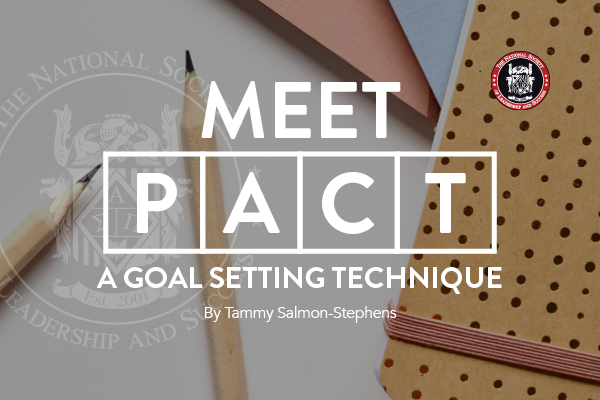By Tammy Salmon-Stephens:
By trade and by education, I'm a STEM person. More specifically, I'm an industrial engineer, where everything is about planning and mapping the steps needed to achieve a specific goal. These types of structured goal setting techniques work in many situations and for many people. But for me, it always seemed like something was missing from this approach.
As Chapter Advisor for the University of Wisconsin, Platteville NSLS chapter, I am continually researching and applying different goal setting strategies. While they come in all different forms, there was one common theme: there is not one goal setting technique that works for every person in every situation.
One technique that appealed to me was PACT, because it focuses on taking action, allows you to reassess, and encourages continuous progress.
What Is PACT?
PACT is a goal setting technique and stands for Purposeful, Actionable, Continuous, and Trackable. Compared to other methods that focus on outcome, PACT goals focus on output.
By focusing on output, some people have found that PACT goals allow them to track progress towards achieving a goal and creating new habits. The PACT technique works especially well for long-term, ambitious goals because they are focused on continuous growth.
Below are the four elements of PACT and how they can help you achieve your goals.
Purposeful
A "Purposeful" effort represents your goal's foundation, its meaning, and the passion that drives you toward achieving it. A purposeful intent does not merely satisfy a fast or frivolous gratification, but rather, it speaks more to the values that fuel your ambitions and actions.
I often connect with students on topics that they can relate to, such as athletics, growing up on a farm, or any other experience where they have set a goal and achieved that goal. In these instances, I "peel the onion back," so to speak, asking the students questions that prompt emotional responses and to learn more about what approach worked for them.
For example, I might ask, "What specifically do you like about your sport, the team members, and even competition in general?" Starting at the surface level and digging deeper helps us to understand why something is important to us and how it feels when you perform certain activities or pursue different goals.
Actionable
Being "Actionable" is about taking action today to avoid overplanning for the future. This means making efforts to change the things within your reach that you can presently control instead of focusing on distant outcomes. Think of "Actionable" as being similar to the adage, "living in the now."
Of course, preparing for the future is essential, but there can be downfalls to overplanning. Many of us over-analyze a situation which can lead to inaction. This “analysis paralysis” keeps us away from how some of us may learn best--trying something new and attempting several iterations after each attempt.
PACT goals allow you to experiment because you can measure your effort (more on this below). It can also prove to be a better mental health approach (which is important as we continue to see a rise in college students' mental health issues), because it allows people to become vulnerable, try new things, fall short, experience miscues, and have trials and errors. This provides a landscape of opportunity for continuous improvement and refinement.
Continuous
With the "Continuous" pursuit of repeatable and straightforward routines, we can avoid “choice paralysis,” when too many options keep you from immediately doing something actionable. Otherwise known as analysis paralysis or FOBO (Fear of a Better Option), it’s a consequence of over-planning and over-analyzing a situation.
Spending too much time on research as opposed to action can be stifling. It's easy to overthink, considering all of the things you don't know yet or of all the possible negative outcomes.
PACT and other similar goal-setting models allow you to avoid those fears through experimentation. It encourages you to get started and experiment through continuous actions and you measure success through your effort and progress.
One of the mantras I teach my students is, "Once I know better, I do better." In other words, through continuous action and experimentation, I learn how I can do better next time.
Trackable
Lastly, there is great value in "Trackable" actions-–a different take on “Measurable” from SMART goals. This approach can positively impact mental health and wellness as it pertains to a sense of accomplishment based on effort and progress.
For example, instead of riding 45 minutes on the stationary bike right away, allow yourself time to build up to that. Realize that just getting on the bike routinely as you work toward your 45-minute goal is commendable in itself. Using the PACT model, you track the days you got on the bike and rode for any amount of time.
This technique is part of Tiny Habits by B.J. Fogg. Changing one tiny thing (such as simply getting on the stationary bike for one minute) helps you create a new habit that will lead to you accomplishing your 45-minute goal.
Examples of PACT Goals
As we look at examples of PACT goals, it’s important to remember that PACT goals are focused on output. This is essential when setting your goals.
Here are two examples of PACT goals:
-
Study at least two hours for every one hour in class and complete all homework for every class on time.
-
Run every day this year.
You can see that PACT goals are designed to get you started right now. What action do you want to take that will help you improve? Once you identify that, you can get started working towards your goal. You don’t need to get a 4.0, but you do need to put in the work every day to get the best grades possible. You don’t need to run a marathon, but you do need to run every day.
Find the Goal-Setting Approach That's Right for You
To find the right goal-setting technique for you or for a specific situation, it’s important to understand the different options available. At the NSLS, we believe in SMART goals because it applies in most situations, provides a solid goal setting foundation, and has helped many of our members achieve their goals. This is why it is one of the pillars of our leadership program.
PACT goals won’t work for everyone and they don’t work in every situation. However, in order to provide our members with the skills and knowledge for many situations, we want to provide an analysis of some of the other goal-setting techniques available so you can achieve your goals!

Tammy J. Salmon-Stephens is the Director of the College of EMS Student Success Programs and leads programs to support women and underrepresented minorities in STEM and student success. She is the recipient of several awards related to diversity and inclusion, specifically related to Women in STEM. She focuses her project management and communication skills on programs and events that improve student success in higher education; specifically, through coaching, mentoring, teaching, identity discovery and development, diversity and inclusion, and self-care. Most notable is her leadership to increase access for women in STEM careers, improve processes removing barriers to success, and improved communication processes. She is the co-advisor for the UW-Platteville NSLS Chapter.






